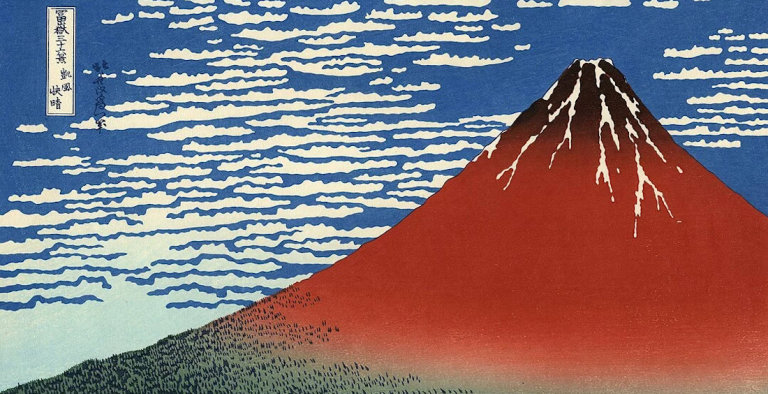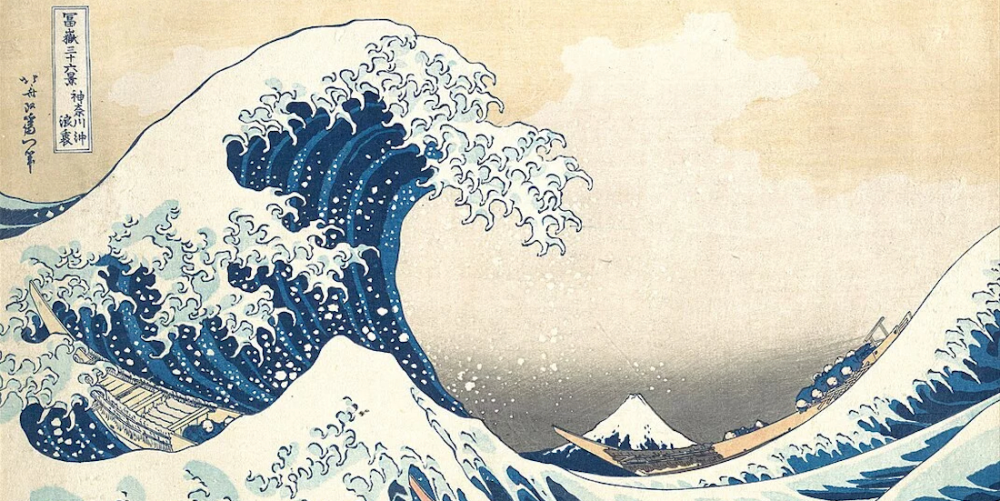
Innovative Woodblock Series Redefines Japanese Art, Inspires Global Masters
New York, N.Y. Katsushika Hokusai‘s “Thirty-six Views of Mt. Fuji” is a masterful series of landscape prints that not only celebrates the majestic beauty of Japan’s most famous mountain but also marks a significant evolution in the art of ukiyo-e, the genre of woodblock printing and painting that flourished in Japan from the 17th to 19th centuries.
Artistic, cultural, and historical significance of Hokusai’s seminal work
Completed between 1830 and 1832, “Thirty-six Views of Mount Fuji” comprises 46 prints, despite its title suggesting otherwise. The series was immensely popular, prompting Hokusai to create an additional ten prints.
At its core, the series is a tribute to Mount Fuji, a sacred symbol in Japanese culture representing both beauty and spiritual significance. However, Hokusai’s approach was innovative; he depicted the mountain from various perspectives, capturing its presence in different seasons, weather conditions, and times of day, reflecting its omnipresence in the lives of the Japanese people.

The most iconic print in the series is undoubtedly “The Great Wave off Kanagawa.” This image, often misinterpreted as a tsunami, depicts a towering wave with Mount Fuji in the background. The wave’s dramatic, almost menacing form contrasts with the serene, distant mountain, highlighting the power and unpredictability of nature.
The print’s dynamic composition and bold use of Prussian blue, a relatively new pigment at the time, exemplify Hokusai’s innovative spirit. “The Great Wave” has transcended its cultural origins, becoming one of the most recognizable works of art worldwide.
Another notable print is “South Wind, Clear Sky,” also known as “Red Fuji”
This print portrays Mount Fuji bathed in the warm, reddish light of early morning, signifying a clear summer day. The simplicity of the composition, with the mountain dominating the scene, emphasizes its grandeur and the artist’s reverence for its beauty. The use of color is particularly striking, with the vivid reds and blues creating a sense of tranquility and majesty.
Hokusai‘s series also includes prints like “Rainstorm Beneath the Summit” and “Fine Wind, Clear Weather,” which showcase his mastery in depicting atmospheric conditions and natural phenomena.
“Rainstorm Beneath the Summit” captures the dramatic contrast between the dark, stormy clouds enveloping the lower slopes of Mount Fuji and the clear sky above. This ability to capture fleeting moments and the ephemeral nature of weather is a testament to Hokusai‘s observational skills and artistic prowess.
The “Thirty-six Views of Mount Fuji” series is not merely a collection of landscapes; it also offers a glimpse into the daily lives and activities of people in Edo-period Japan.
Prints such as “In the Well of the Great Wave off Kanagawa” and “Kajikazawa in Kai Province” depict fishermen and farmers going about their work, with Mount Fuji as a constant, reassuring presence in the background. These scenes reflect the harmonious relationship between humans and nature, a theme central to Japanese culture and philosophy.
Hokusai deeply influenced by both Japanese and Western artistic traditions
The use of perspective and the depiction of natural light show the impact of Western art, which Hokusai encountered through Dutch prints that made their way to Japan during the Edo period. His integration of these techniques with traditional Japanese aesthetics created a unique style that has left a lasting legacy in both Eastern and Western art.
Popularity and influence of “Thirty-six Views of Mount Fuji” extended beyond Japan
The series played a significant role in the Japonism movement that swept through Europe in the late 19th century, profoundly influencing Western artists such as Claude Monet, Vincent van Gogh, and Edgar Degas. The bold compositions, use of color, and depiction of everyday scenes in Hokusai’s prints resonated with these artists and contributed to the development of Impressionism and Post-Impressionism.
“Thirty-six Views of Mount Fuji” holds a cultural and historical importance
The series was created during a period of great change in Japan, as the country began to open up to foreign influences after centuries of relative isolation. Hokusai’s work captures a sense of national identity and pride, rooted in the enduring presence of Mount Fuji.
In conclusion, Katsushika Hokusai’s “Thirty-six Views of Mount Fuji” is a monumental achievement in the history of art. It represents the pinnacle of ukiyo-e, showcasing Hokusai’s innovative spirit, technical skill, and deep appreciation for the natural world.
Through his masterful prints, Hokusai not only immortalized Mount Fuji but also left an indelible mark on the world of art, bridging cultures and inspiring generations of artists. The series remains a timeless testament to the beauty and power of nature, as well as the enduring human spirit.
Hokusai’s Thirty-six Views of Mt. Fuji: Enduring Artistic Legacy (June 25, 202; republished June 22, 2025)
75-Word Summary
In this audio summary, discover how Katsushika Hokusai’s Thirty-six Views of Mount Fuji revolutionized Japanese art and captivated the world. Created between 1830 and 1832, the series features forty-six prints that showcase Mount Fuji from diverse perspectives, seasons, and moods. Hokusai’s bold use of color, inventive compositions, and integration of Western techniques influenced Impressionist masters and remains a powerful symbol of Japan’s cultural identity and artistic innovation today.